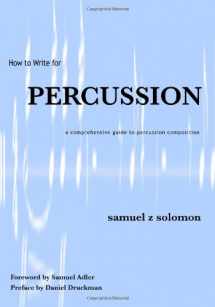
How to Write for PERCUSSION
Book details
Summary
Description
How to Write for PERCUSSION is a comprehensive text that clearly explains and simplifies all issues that percussionists and composers face with respect to each other. Written from a percussionist's perspective, it examines the behind-the-scenes processes to uncover all the tools the composer needs to comfortably create innovative and skilled percussion composition.
If you are a composer or arranger and have ever had a question about percussion writing, How to Write for PERCUSSION is the definitive source. Whether you have years of percussion writing experience or no idea how to even approach it, this book will give you hundreds of great new ideas and will show you exactly how to realize them in your music.
There are nine chapters. The first four consider issues that apply to all percussion.
1. General Logistics 2. General Notation 3. Beaters 4. Tone Color
1. General Logistics explores issues of movement, instrument choice, instrument setup, concert production, and sound production. These are the often overlooked concerns which significantly influence the success of the composition.
2. General Notation details the key notational concepts for percussion writing, including guidelines for how to create parts and scores, how to set up a notational system for multi-percussion setups, and how to deal with articulation, phrasing, note length, and special effects.
3. Beaters describes each beater, its specific uses, special effects, and issues of changing beaters within a piece.
4. Tone Color discusses the physical factors that can be used to manipulate timbre on all percussion instruments.
The following five chapters discuss specific types of instruments.
5. Drums 6. Keyboard Percussion 7. Metal 8. Unpitched Wood 9. Miscellaneous Instruments
Drums, Keyboard Percussion, Metal, and Wood deal with instruments that are struck. Miscellaneous Instruments deals with instruments that are scraped, cranked, shaken, and blown through, as well as some struck instruments that do not fit into the other categories.
The five appendices expand and reinforce the concepts detailed in the rest of the book.
A. Sample Setups B. Scores with Comments C. Beaters D. Dynamics E. Suggested Works
A. Sample Setups is a collection of instrument lists with their corresponding setup diagrams and instrument keys.
B. Scores with Comments presents excerpts from real scores with comments that elaborate upon important logistcal and notational issues.
C. Beaters charts the appropriateness of various beaters on various instruments.
D. Dynamics charts the relative dynamics of various instruments struck with various beaters.
E. Suggested Works is an annotated list of works that use percussion well.
With hundreds of musical examples, diagrams, charts, photos, and pages of text, there are few questions this book will not answer.


We would LOVE it if you could help us and other readers by reviewing the book
Book review



